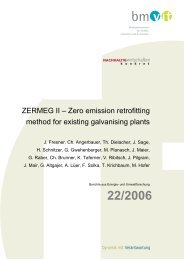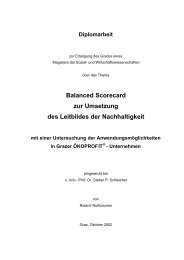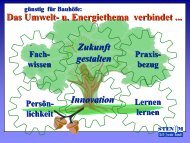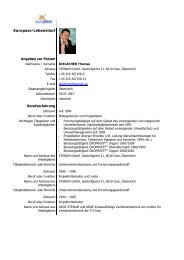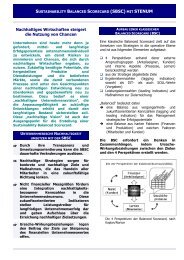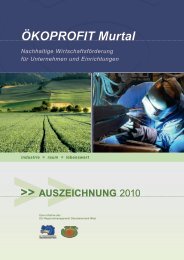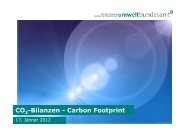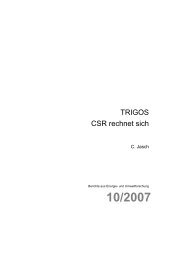Promoting Resource Efficiency in Small & Medium size ... - UNEP
Promoting Resource Efficiency in Small & Medium size ... - UNEP
Promoting Resource Efficiency in Small & Medium size ... - UNEP
You also want an ePaper? Increase the reach of your titles
YUMPU automatically turns print PDFs into web optimized ePapers that Google loves.
In Figure 21 the <strong>in</strong>crease <strong>in</strong> variation that correlates to the decrease of<br />
production <strong>in</strong>dicates a deficit of process control. From the extrapolation<br />
of the <strong>in</strong>terpolation l<strong>in</strong>e towards high production, the optimum<br />
consumption can be derived. Plott<strong>in</strong>g a similar diagram with total daily<br />
water consumption and extrapolation of daily water consumption towards<br />
zero production would show fixed consumption, e.g. for daily clean<strong>in</strong>g.<br />
3.5 Act<br />
In the ‘Act’ phase the follow<strong>in</strong>g elements are important:<br />
• Preparation of an action plan<br />
• Cont<strong>in</strong>ued implementation of <strong>Resource</strong> <strong>Efficiency</strong> options<br />
(maybe <strong>in</strong> another thematic area)<br />
• Monitor<strong>in</strong>g and review<strong>in</strong>g of performance<br />
• Reward<strong>in</strong>g good performance; do not forget to reward the ones<br />
beh<strong>in</strong>d the success!<br />
Prepare an action plan to track implementation of <strong>Resource</strong> <strong>Efficiency</strong><br />
goals and prepare regular reports to management on the progress to<br />
justify time and resources used on the programme.<br />
3.6 Overlaps <strong>in</strong> the thematic areas<br />
As shown <strong>in</strong> table 9, there are a number of overlaps <strong>in</strong> efficient use of<br />
water, energy, materials and chemicals.<br />
3.7 Why <strong>Resource</strong> <strong>Efficiency</strong> is safe and profitable at<br />
the same time<br />
Implement<strong>in</strong>g <strong>Resource</strong> <strong>Efficiency</strong> will make your company more<br />
cost-effective. Use materials, energy, fuel and other resources more<br />
efficiently and cut the cost of waste disposal and <strong>in</strong>put purchases.<br />
<strong>Resource</strong> <strong>Efficiency</strong> projects let you benefit from improved cash flow,<br />
because of reduced expenses for materials and energy and more rapid<br />
return on <strong>in</strong>vestment because of less fixed capital for stored materials<br />
and chemicals.<br />
Companies practic<strong>in</strong>g <strong>Resource</strong> <strong>Efficiency</strong> reduce environmental and<br />
bus<strong>in</strong>ess risks, thereby <strong>in</strong>creas<strong>in</strong>g their credit-worth<strong>in</strong>ess. You can<br />
also improve your f<strong>in</strong>ancial performance by build<strong>in</strong>g a portfolio of<br />
environmentally sound and socially responsible <strong>in</strong>vestments.<br />
A basic premise beh<strong>in</strong>d safer production is that reduc<strong>in</strong>g hazard, rather<br />
than controll<strong>in</strong>g exposure, most effectively manages chemical risk. This<br />
means it is safer to choose <strong>in</strong>herently less hazardous chemicals rather<br />
than attempt to control the exposure risk of a hazardous chemical,<br />
which is the traditional th<strong>in</strong>k<strong>in</strong>g beh<strong>in</strong>d risk management.<br />
Exposure controls can and do fail, and products are used <strong>in</strong> ways that<br />
were never <strong>in</strong>tended. Therefore the most effective means to reduce risk<br />
is to reduce hazard by us<strong>in</strong>g <strong>in</strong>herently safer chemicals.<br />
Your company will become more competitive, as <strong>Resource</strong> <strong>Efficiency</strong><br />
practices improve your image and the quality and safety of your<br />
products. <strong>Resource</strong> <strong>Efficiency</strong> also reduces environmental, health and<br />
liability risks and, by conform<strong>in</strong>g to environmental standards, your<br />
company can export to new markets.<br />
The follow<strong>in</strong>g case study illustrates the importance of mak<strong>in</strong>g <strong>Resource</strong><br />
<strong>Efficiency</strong> an ongo<strong>in</strong>g goal and the results to expect from a susta<strong>in</strong>ed<br />
effort.<br />
The company <strong>in</strong> the follow<strong>in</strong>g case study started implement<strong>in</strong>g<br />
a <strong>Resource</strong> <strong>Efficiency</strong> programme <strong>in</strong> 1997 as part of a regional<br />
environmental programme. Over the years, the company cont<strong>in</strong>ued<br />
stepp<strong>in</strong>g up their environmental management system and expanded<br />
to a full-fledged <strong>in</strong>tegrated management system, <strong>in</strong>clud<strong>in</strong>g quality<br />
management, health and safety, risk and <strong>in</strong>novation management.<br />
Secondary Overlap Water Energy Materials and waste Chemicals Health and safety<br />
Water - Less water means less<br />
energy for pump<strong>in</strong>g, less<br />
water as solvent means<br />
less energy e.g. for dry<strong>in</strong>g,<br />
recovery of hot water<br />
means less energy to heat<br />
water<br />
Less water consumption<br />
means less need for<br />
treatment and often less<br />
sludge to treat and to<br />
dispose of<br />
Less water means less<br />
chemicals for physical<br />
chemical treatment of<br />
water and wastewater<br />
Water spills can cause<br />
slippery ground, electric<br />
defects and cause<br />
accidents<br />
Energy<br />
Materials<br />
Chemicals<br />
Less energy means less<br />
need for cool<strong>in</strong>g (water<br />
for once through cool<strong>in</strong>g<br />
or for boiler and cool<strong>in</strong>g<br />
tower)<br />
Less material losses mean<br />
less need for clean<strong>in</strong>g<br />
Less spills mean less<br />
water for clean<strong>in</strong>g, less<br />
chemicals mean less risk<br />
for wastewater load<br />
- Less energy means less<br />
fuel and coal to transport<br />
and manipulate<br />
Less material losses mean<br />
less energy for recycl<strong>in</strong>g<br />
(for mill<strong>in</strong>g waste, for<br />
melt<strong>in</strong>g recycl<strong>in</strong>g material)<br />
Less chemicals require<br />
less use of ventilation,<br />
extraction and eventual<br />
treatment of exhaust gas<br />
(e.g. by post combustion)<br />
Less need for water<br />
makeup means less<br />
need for water treatment<br />
(biocides, anti foulants,<br />
physical-chemical<br />
treatment of water)<br />
- Less process<strong>in</strong>g of<br />
materials often means<br />
less auxiliary materials<br />
(additives, lubricants)<br />
Less use of chemicals<br />
means less need to<br />
clean up spillages by<br />
absorbents, generates less<br />
waste from neutraliz<strong>in</strong>g<br />
or dispos<strong>in</strong>g of residual<br />
chemicals<br />
Hot surfaces, steam leaks<br />
or hot liquids can hurt<br />
workers<br />
Uncontrolled dust can<br />
cause lung problems for<br />
workers or even explosion<br />
problems<br />
- Spills of chemicals can<br />
cause accidents and<br />
emissions which endanger<br />
workers health<br />
Table 9: Overlaps between water efficiency, energy conservation, material efficiency and chemicals<br />
29





